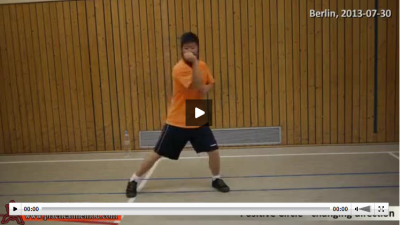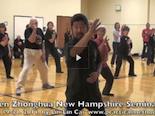Mini Lesson on how direction of movement is changed through the workings of waist, dang, kua, knee and foot exchanges. The example used for this concept is the circles in the foundation exercises.
Presenter: Chen Zhonghua Length: 16 min. In: English Year: 2013 Difficulty:2/5 At:Berlin




{ 25 comments… read them below or add one }
This video explains how to generate, practice and develop force in the positive circle. It is a good follow up to “Stretching in Circle.” Some fun and interesting drills for training the circle are given.
Welcome everyone to this video! I have provided the following guided reference. Please feel free to ask any questions related to the video.
As a fresher, the three counts of the positive circles are:
1) In with elbow
2) Turn with waist
3) Out with hand
We can also say:
1) In with elbow
2) Turn with kua
3) Out with finger
1:00 For the 2nd count of the right positive circle, we stretch the right heel against the right elbow by pushing into the right heel.
For the 3rd count of the right positive circle, we stretch the left heel against the right hand by pushing into the left heel.
1:25 Transitioning from the 2nd count of the positive circle to the 3rd count requires the turning of the joint. This allows us to change direction. In the future, that switching will be very small. The smaller the better.
3:25 At the beginning, our movements will be very coarse, so much that we are tossing our body a lot. Eventually, it will be more fine and our body won’t toss anymore.
3:40 We must use exaggerated movements at the beginning to understand how the energy should be flowing. At the end, even when externally it does not appear to be like that, the way the energy flows remains the same.
I agree with this now after failing in progressing with my PM skills. Master Chen makes an important point to do things exaggerated at first. We are encouraged to do it in exercises during the workshops. At the end of the day, if repeated enough, there will be a memory of that energy flow. It also opens up energy paths (pipes) until the kinks in the pipes are smoothed out, another way to put this is that our kua and shoulders open up very very gradually.
Please correct me if my current understanding of this is wrong and help me progress my understanding. Thank you!
Imagine that you are opening the lid of a jar. When it is stuck or firmly sealed, we need to use a lot of effort to open it. Once it is open, opening or closing the jar does not take nearly as much effort. We sometimes wrap a rubber band around the lid first to more easily open the jar. It creates more friction between your hand and the lid to prevent sliding off, and it transfers your power to where it needs to be to open the lid Our joints are like the stuck lid.
A stuck lid is a great way of describing how our joints feel when we have not opened them.
4:01 In Chen Taiji, no one should be able to find your direction because it is in every direction. For a rotating object, regardless of how you touch it, it feels like that it is coming at you.
I don’t feel the direction until I’ve fallen 😀 Then it’s too late.
4:13 Exercise 1: Train splitting without doing the entire positive circle. Later, we incorporate it into the positive circle.
https://youtu.be/brS3Kba6jbc
6:15 Exercise 2: Train opening of the kua.
I am having a very hard time seeing what is happening here. When the kua is opening correctly, is one rod end held stationary while the other rod end rotates. Then the previously rotating rod end is held stationary while the previously stationary rod end rotates?
Or, is the middle of the rod being held stationary while both rod ends rotates simultaneously in opposite directions? Perhaps it’s not even any of these that I described.
I hope my question makes sense. Thank you.
Yes.
I will illustrate the idea in a different way. Put two fists next to each other with only the middle fingers’ 2nd knuckles touching. Rotate one fist while the other one is fixed, switch fists, or rotate both fists with something commonly shared in the middle not moving.
Thank you for that example, Kelvin.
I am going to have to play with this example and this concept for a while to really understand it.
As an action that we actually do, it can be:
1) Lock the hand, move the chest.
2) Lock the chest, move the hand.
Worm action.
Great! I understand it better now with both of the examples you provided.
9:00 Master Chen explained the difference between dantian rotation vs dantian wiggling. Dantian rotation requires a true centre that does not move. Only by achieving dantian rotation, you can realize the true power of the dantian.
12:30 How do we rotate (or do a circle) without being poked through our dantian and getting pinned there? We need to break a circle into two halves. We need to lock one side and move the other for half of the circle, and then switch to lock the opposite side and move the other. There is no full circle visually, but the opponent would feel the complete circle. (As I understsand, it’s the energy that keeps going forward without ever going backward. Here is an article I have written previously on this topic: S-curve is really the circle.
The other day in class disciple Brian Chung reminded me of “What is done cannot be undone” as taught by Master Chen.
We cannot do the second half of the circle to make a full rotation unless what has been done by the first half of the circle is locked.
I am still letting go what I have done. This is a habit and also an attempt to avoid discomfort.
This example I will provide is a bit of an extension of the above concept because I am going into spirals (I currently understand spirals as one circle created after another – could be wrong!). For example, I remember you taught me that each time I do the positive circle there is no reset between each positive circle. Tightness increases with each positive circle.
> The other day in class disciple Brian Chung reminded me of “What is done cannot be undone” as taught by Master Chen.
> We cannot do the second half of the circle to make a full rotation unless what has been done by the first half of the circle is locked.
Yes
> I am still letting go what I have done
Don’t we all?
> This is a habit and also an attempt to avoid discomfort.
Doing yilu is never comfortable. When we break each move into different steps, we make an action, we hold that position, and we make another action from there.
> spirals as one circle created after another
No one can do a full rotation with one body part. We can attempt to do an approximation of a full rotation by using different body parts one after another. Imagine that you need to rotate a mug on the table 360 degrees while staying on the table. You are only allowed to do it with one hand, and that hand can only touch the ear of the mug from the side of the mug. How would you do it? Let’s say the ear is on the right side at first. You would start the rotation by holding the ear and turn the mug for about 180 degrees, and the ear will be on the left. You will have to let go of the ear, move your hand around the mug, hold the ear again and rotate the mug the remaining 180 degrees. The mug has only travelled in one direction with no retreat or reset. You have to complete the full rotation in two halves or two separate actions.
In this other Chinese video, I have mentioned something similar about rotation 旋转 from that video.
http://www.shiyongquanfa.cn/archives/14132
A spiral requires at least two pairs of yin and yang. The two pairs of yin and yang must intersect. This means that we need two different splits.
very helpful, I’ve been watching the video, and this part was a bit confusing. The cup analogy is brilliant. I now *begin* to understand. If someone other than the person doing the turning closes his eyes and puts a finger on the cup, he will sense a full rotation, though the turner has made two distinct moves.
The cup analogy is a great way of describing what we are trying to do to create a full rotation. Thank you Kelvin.
15:10 Master Chen demonstrated the idea of locking one side and moving the other with his dantian in this section of the video. Please watch repeatedly until you can actually see it.